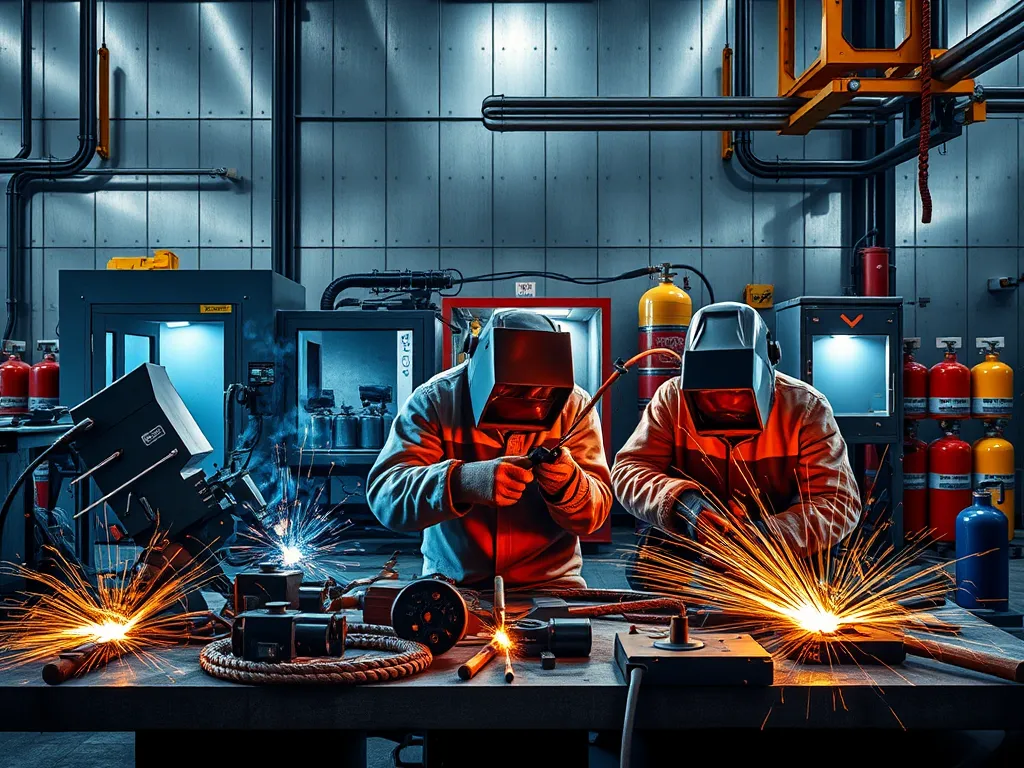Explore the Most Common Type of Welding Techniques Today

Comprehensive Overview of Welding Techniques
Welding Techniques are a critical part of fabrication and metalworking, encompassing various methods used to join materials together. These techniques are vital in industries ranging from construction to automotive, as they ensure the structural integrity, safety, and performance of welded products. This article delves into popular welding techniques, highlighting their unique characteristics, benefits, and applications.
Among the various welding techniques, MIG (Metal Inert Gas) welding stands out for its efficiency and versatility. It employs a continuous solid wire electrode and an inert gas to protect the weld pool from contamination. Additionally, TIG (Tungsten Inert Gas) welding is known for its precision and ability to weld a wider range of materials, making it ideal for thin materials and high-quality welds. Other techniques, such as Stick welding, are favored for outdoor applications and environments where portability is crucial.
Flux-Cored Arc Welding (FCAW) is another technique that has gained popularity due to its high-speed production capabilities and effectiveness in thick materials. These welding techniques differ in terms of equipment, skill requirements, and applications, making it essential for professionals to choose the appropriate method based on the project requirements.
Safety practices in welding are paramount, as the process involves risks such as exposure to harmful fumes, high temperatures, and electric shock. Proper personal protective equipment (PPE), safety training, and adherence to regulations are essential to mitigating hazards associated with welding. Understanding these techniques and their implementations can lead to better outcomes in both safety and quality.
to better understand the fabrication process, it's essential to explore the various Common welding methods used today.
In this comprehensive overview of welding techniques, we will explore key methods such as MIG, TIG, Stick welding, and Flux-Cored Arc Welding, along with essential safety practices and considerations.
MIG Welding
MIG (Metal Inert Gas) Welding is a welding process that uses a continuous solid wire electrode coupled with a shielding gas to create a weld. The process is automated, making it suitable for high-speed production. MIG welding is often used in manufacturing and repairs due to its efficiency and ability to weld a variety of materials, including steel, aluminum, and stainless steel.
the rise in Arc welding popularity is evident from the increasing number of services offering state-of-the-art solutions.
The advantages of MIG welding include its speed, ease of use, and versatility. It produces clean welds with minimal spatter, reducing post-weld cleanup. The process also allows for welding in all positions, making it adaptable for various applications.
professionals often rely on Shielded metal arc welding for its versatility in various applications.
MIG welding is commonly used in automotive manufacturing, construction, and fabrication industries. It is suitable for projects requiring a fast welding process, such as assembly lines, and is also used for repairs and maintenance.
When comparing MIG welding with other welding methods, its efficiency and speed typically give it an edge in production environments. However, it may not be the best choice for thick materials compared to Stick welding, nor does it provide the same level of precision as TIG welding.
Safety practices in MIG welding include ensuring proper ventilation to avoid fume buildup and using PPE such as welding gloves, helmets, and protective clothing to shield against heat and sparks. Regular equipment inspection and following manufacturer guidelines for gas cylinder storage are also essential for safe operation.
TIG Welding
TIG (Tungsten Inert Gas) Welding is a precise welding technique that uses a non-consumable tungsten electrode to produce the weld. It is known for its ability to create high-quality welds on thin materials, providing excellent control over the welding process and the weld pool.
The benefits of using TIG welding include its versatility in welding a variety of metals and the high-quality finish it provides. It allows for precise control over the heat and weld pool, making it suitable for applications where appearance and integrity are critical.
Key industries utilizing TIG welding include aerospace, medical device manufacturing, and art industry sculpture fabrication, where precision and cleanliness are paramount.
Comparing TIG with MIG welding, TIG offers greater control and quality but is generally slower and requires more skill. It’s ideal for intricate work, whereas MIG is more efficient for larger projects and thicker materials.
TIG welding safety measures include using appropriate PPE, maintaining a clean workspace to prevent accidents, and ensuring proper gas handling to avoid leaks and exposure to harmful elements.
Stick Welding
Stick welding, also known as Shielded Metal Arc Welding (SMAW), is a manual welding process that utilizes an electrode coated in flux to create a weld. The flux generates a shielding gas that protects the weld area from contamination.
The advantages of Stick welding include its ability to weld in various positions, use in outdoor environments regardless of weather conditions, and effectiveness in welding thick materials. It is often the go-to method for maintenance and repair work.
Common uses for Stick welding comprise construction, shipbuilding, and metal fabrication, especially in structural applications where size and positioning may be challenging for other methods.
When comparing Stick welding to MIG and TIG, it is typically easier to learn but requires more skill for executing clean welds. It is less efficient but can handle outdoor conditions that may hinder other processes.
Safety guidelines for Stick welding emphasize wearing appropriate PPE, such as helmets and gloves, maintaining proper ventilation, and being aware of electrical hazards associated with the process.
Flux-Cored Arc Welding (FCAW)
Flux-Cored Arc Welding (FCAW) is a variation of MIG welding that uses a tubular wire filled with flux instead of a solid wire. The flux generates a shielding gas as it melts, making it useful for outdoor applications and for welding thicker materials.
Benefits of Flux-Cored welding include its high deposition rates, adaptability to different environments, and the ability to create strong welds in various positions. It is particularly effective in situations where portability is required.
Typical applications for FCAW include construction projects, shipbuilding, and manufacturing processes that require speedy and robust welds, especially in heavy materials.
FCAW differs from MIG in that it allows for more versatility in work settings, particularly for outdoor use. However, MIG welding provides cleaner welds and requires less post-weld cleanup.
Safety tips for FCAW include using proper ventilation, wearing appropriate PPE to protect against sparks and heat, and following safe handling procedures for the welding equipment.
Welding Safety Practices
Safety in welding is of utmost importance, as the process poses significant risks such as burns, electric shock, and exposure to hazardous materials. Implementing safety practices can mitigate these risks and ensure a safe working environment.
Personal Protective Equipment (PPE) for welding typically includes helmets with proper filters, fire-resistant gloves, aprons, and safety glasses. This equipment protects welders from sparks, heat, and harmful radiation.
Common welding hazards include exposure to fumes, UV radiation, and potential fire hazards. Solutions involve using adequate ventilation, ensuring proper work area setup, and being aware of fire regulations in welding environments.
Regulatory compliance for welding safety involves adhering to standards set by organizations such as OSHA, ensuring that all equipment is maintained, and that operators are trained in safe welding practices.
Training and certification in welding safety are essential not only for compliance but also for fostering a culture of safety within the workforce, reducing the likelihood of accidents and injuries.
